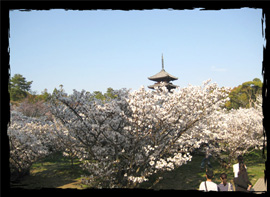 |
 |
Recent studies have overturned the bedrock theory |
 |
| |
The unique cherry trees at Ninnaji Temple, known for their late blossoms, are called Omuro sakura. Only growing to a height of about 2 meters, they are a variant of the satozakura (village cherry trees). There are are several variants of the Omuro sakura here, including the single-petaled and double-petaled varieties, and the glorious way they bloom led to the designation of Ninnaji Temple as a site of national scenic beauty in 1924. There are also rare cherry tree variants on the grounds, such as the kizakura (yellow cherry trees with double-petaled blossoms, and another, often called Gyoikozakura, with light green blossoms. The Omuro sakura have been very popular with the local citizens since the Edo Period and are the source of many Japanese poems. The question of why these trees are so low in height has long been a mystery, so much so that it is known as the "Riddle of the Omuro sakura." However, results from the latest soil studies showed that instead of the expected bedrock, there is clay-like soil under the cherry trees that that is very low in nutritional elements such as carbon and nitrogen. These studies also showed that the trees’ roots are surrounded by hard-packed soil so it is difficult for them to spread. There is a folk song that goes, "I love plain women, even though, like the Omuro cherry trees, their blossoms are low." Containing a pun on the phrase hana ga hikui, which means both ‘low blossom’ and ‘small (low) nose’, it alludes to fact that the Omuro cherry trees are also known as otafuku sakura. Otafuku is an archetypal well-loved but plain woman, and is characterised by a small nose. Of course, being so low has surely been one of reasons for the trees’ continuing popularity over the years. |
| |
|
|
 |
 |
| Omuro cherry trees |
|
|
|

